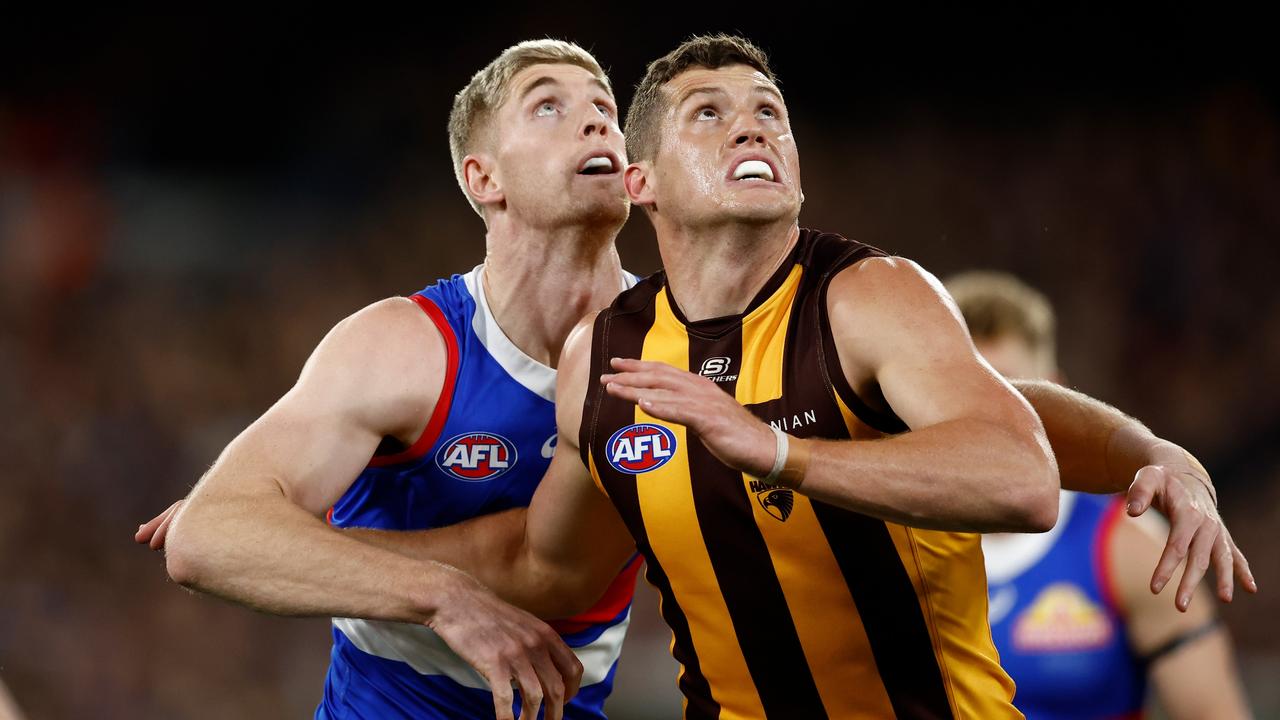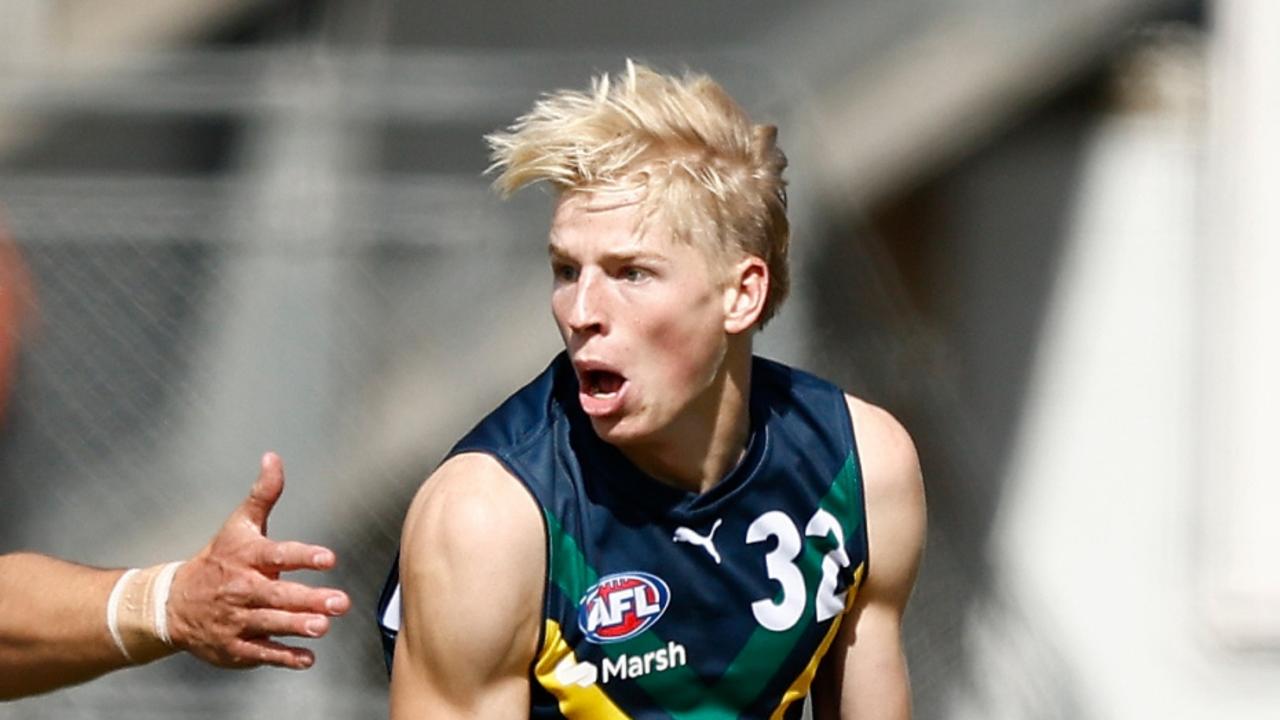How Geelong rebuilt its forward line with added leg speed to prepare another premiership push
Just one player is left in Geelong’s forward line from the 2020 grand final. And the style of Chris Scott’s team is just as unrecognisable. Here’s how they pulled together a rag tag attack.
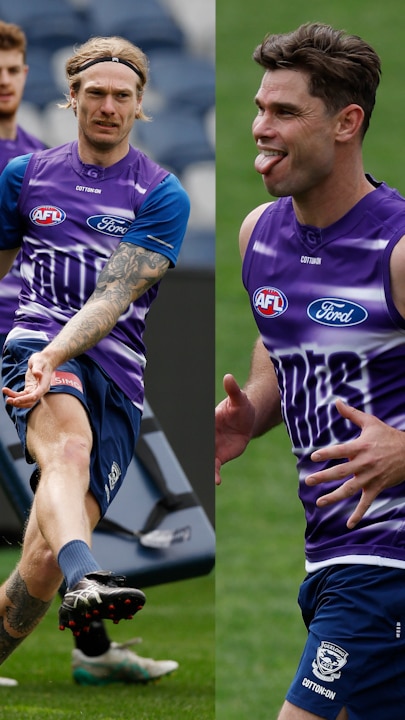
AFL
Don't miss out on the headlines from AFL. Followed categories will be added to My News.
There’s the hard-runner in long sleeves who was recruited out of the SANFL before he even had a manager.
The natural-born footballer that has been shunned his whole life for kicking around corners and looked nowhere near it in his first season in the AFL.
The 26-year-old plucked from the VFL.
You’ve got the giant 800m runner and the classic small forward who was cut twice and picked up by Geelong for nothing.
Then there is the former Magpie who wanted to be an athlete and, of course, the superstar goalkicker who barely played football as a junior.
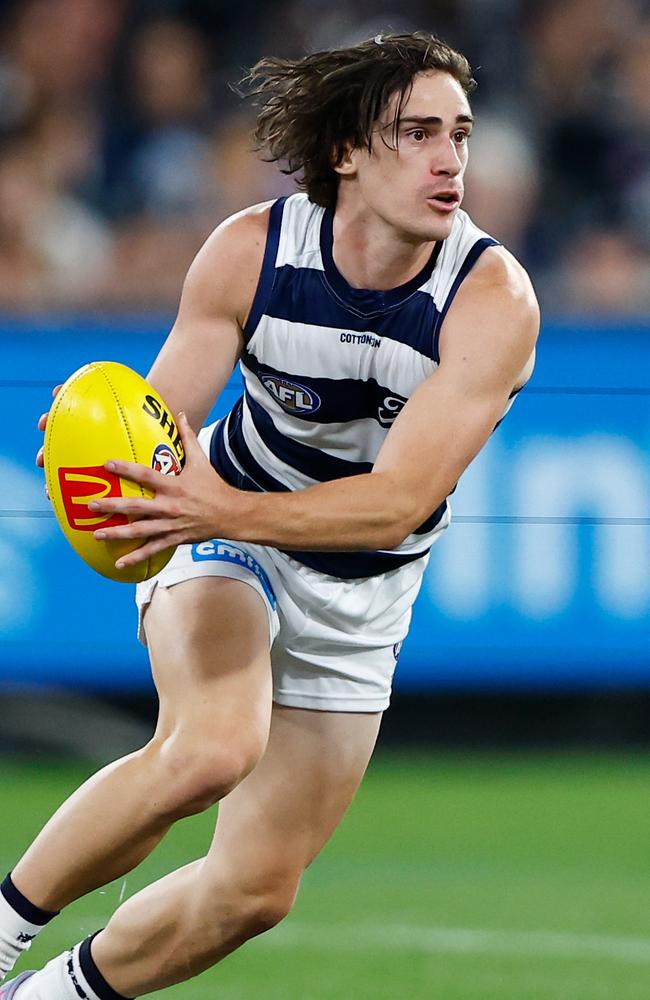
Having made a grand final in 2020 with a forwardline full of hard nosed footballers, Geelong coach Chris Scott has moulded his new attack around speed to devastating effect.
And the Cats have managed to pull together that merry band of attackers from all over the place.
In that Gabba decider that was owned by Dustin Martin during the peak of Covid, Geelong’s named front six was Luke Dahlhaus, Gary Rohan, Gryan Miers, Mark O’Connor, Tom Hawkins and Gary Ablett, with Sam Simpson off the bench to play at half-forward.
Miers will be the sole survivor of that attack in Saturday’s preliminary final against the Brisbane Lions and Geelong’s game style will be just as unrecognisable.
He will line up next to talls Shannon Neale and Jeremy Cameron, with smalls Tyson Stengle, Brad Close and Shaun Mannagh.
The Cats of that Covid era played a methodical, build-up style of kicking in a bid to slow the game down, hold on to the ball and not let the game become a track meet.
Those on the inside knew that they didn’t have the electric runners that Damien Hardwick’s Richmond lined up across the half-forward line, and if the game broke into a running race the Cats would be left at the back of the pack.
Forced to play a slower style, Scott still guided that team to the very edge of a premiership -it took until the second half of that grand final for the Tigers to overtake on the run to the line.

Now, the Cats love to play in an open field, happy to at times blindly get the ball forward and go direct, in the hope of getting over the back of a defence.
It worked a treat in the qualifying final, as the speed of Geelong’s attack slipped through the hands of Port Adelaide’s defence whenever the ball hit the ground.
This year, Geelong ranks sixth for inside-50s per game but tops the league in marks when in there, able to use the space and leg speed to create set shots.
In remodelling the Geelong forwardline, the Cats didn’t deliberately go shopping for leg speed, but found it anyway.
Suddenly blessed with speed, Scott and his coaching team realised they had the weapons to play closer to Richmond’s style, if with a little more control.
Close was an emergency for that grand final and had been taken as a 21-year-old with pick 14 in the 2019 rookie draft from SANFL club Glenelg.
The long-sleeved kid was found by former talent spotter Troy Selwood, with the Cats keen on him before he even signed a player manager.
No other club spoke to Close before he was drafted by Geelong and no club has inquired about poaching him since, yet he would walk into the high half-forward role at 17 other clubs.
One senior Geelong figure simply described his recruitment as “just a really, really great pick”.
Miers established himself in 2019 as a goalkicker, having dominated the under-18s and kicked seven goals for the Geelong Falcons in the 2017 TAC Cup grand final.
Taken with pick 56 in that year’s draft, Miers didn’t come close to playing in his first season and some senior figures thought if he didn’t have a two-year draftee contract he may not have been on the list in 2019.
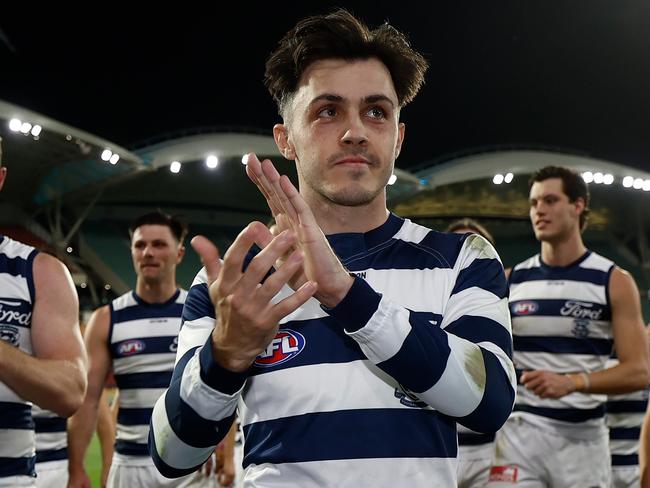
But the Grovedale kid dominated his second pre-season and became a regular in the team from 2019 onwards.
Miers is well known by now for his homegrown kicking style, that seemingly never misses a chest, but has developed into being more than handy when pushed up the field into stoppages and can burn opponents coming forward from clearances.
As the Cats buried the Power in the final term in the qualifying final, Miers won first possession at a ball up on the wing.
The Cats handballed their way forward and suddenly Miers was loose, with no Power players in sight, and nailed the goal from the 50m line.

Getting up high and then beating the opposition back from a stoppage is a role shared between Miers, Close and Mannagh.
Mannagh said the extra stoppage craft was a balancing act, depending on using that speed to get forward and make sure the opposition doesn’t have a spare defender.
“We do anything we can do to help out the mids and try not to give them a spare back,” he said.
“But if we do, we back our keys in to compete and then make sure we get back to the fall of the ball. It is all depending on the situation of the game and where the ball is.”
Those players are just as deadly at stoppages in the forward 50 – the 31 points the Cats scored from that source in the qualifying final thrashing of the Power was the second-most in Champion Data’s records for a final.
Neale – the highest credentialed forward in terms of the draft, having been taken at No. 33 in the 2020 draft, just months after that Brisbane grand final – has supplanted retiring legend Tom Hawkins in the forward line.
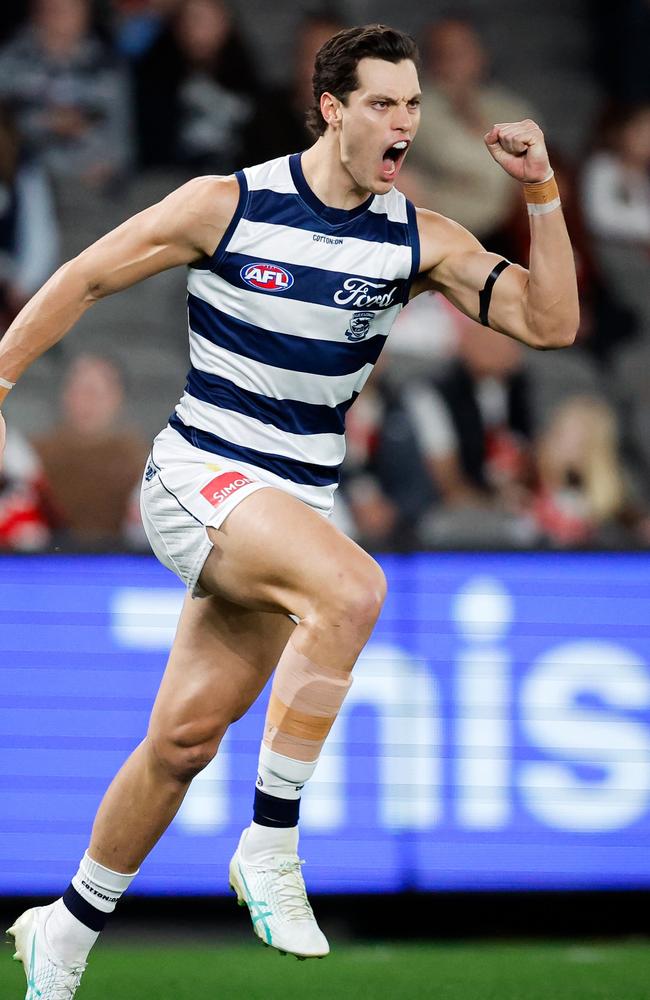
A man mountain at 203cm, Neale was a national track star, roaring through the 400m and 800m as a youngster in Perth.
Henry also spent plenty of time in athletics, like his older brothers, before really becoming focused on footy when his brother Jack was drafted by the Cats.
The main man upfront, Cameron, was a trade in from western Sydney, a freak athlete who can kick the ball as well as anyone, he barely played football until his late teens.
He chose Geelong’s lifestyle in a declaration that went public just days before that 2020 decider.
Never the greatest aerial threat, Cameron thrives in Geelong’s open fields, given he is pretty much guaranteed to be a better runner than his match-up every week.
All-Australian Stengle spends the most time closer to goal of the group with his ingenious goalsneak ability shining after he was let go by Richmond and Adelaide before signing with Geelong for nothing as a free agent.
Every now and then winger Ollie Dempsey slides forward and kicks a goal, a rising star winner plucked from obscurity as a rookie after being a basketballer as a kid.
The fabled Geelong recruiting team was keen on VFL gun Mannagh before he bagged six goals in a losing VFL grand final for Werribee last year.
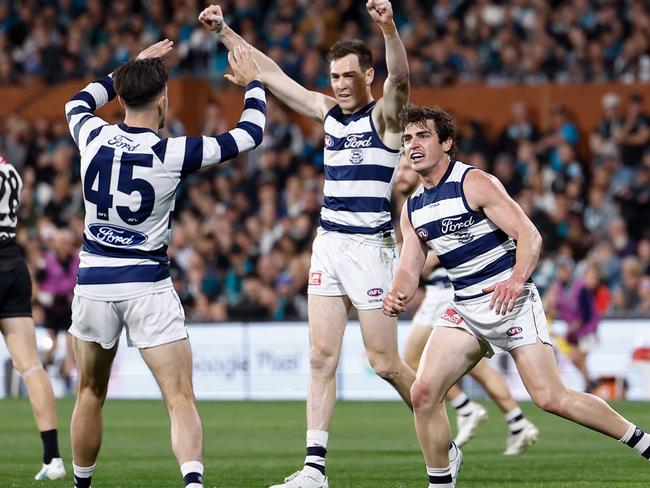
Even after being drafted at age 26, Mannagh was forced to spend time in the state league this year to learn his role in Geelong’s system, and has since emerged as one of Champion Data’s darlings forward of the ball.
A returnee to the Cats this year after a stint in Adelaide – where he was named the assistant coach of the year – James Rahilly guides the forward line.
“Rahls runs a really good show here and makes sure we have a bit of fun in there and that we are right across who we play against each week,” Mannagh said.
“Our meetings are right to the point and we have a lot of blokes with natural flair who can bring that.
“They are really good meetings and obviously it shows when we go out and play on the weekend.
“System trumps everything really. If we aren’t set up the right way we can’t show that flair and we have seen that in vision plenty of times throughout the year that if we aren’t set up correctly then we wont kick a goal or be in the right spot for that.”
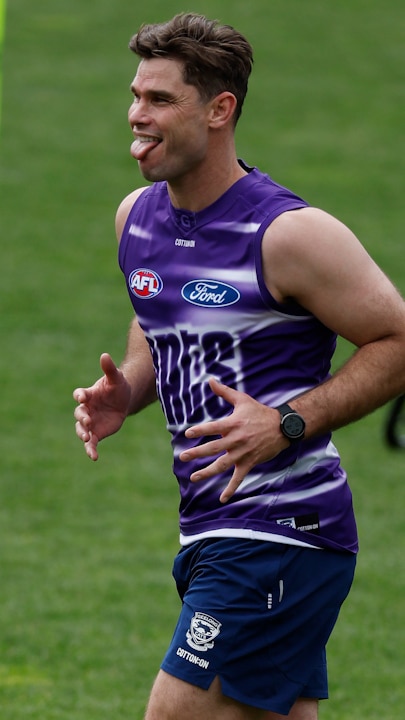
When the Cats flow, few sides are as good to watch, as the hooped jumpers charge into an open 50m arc.
Close said the highlight goals come after the leg work.
“We have a few players who are really good at that, Ollie Dempsey is really good at working hard from the wing getting inside 50 as well and we have guys like Gryan and Shaun Mannagh now,” he said.
“It all works off getting up the ground and helping defence first but then you get the rewards if the ball is flowing. That is another thing we love, when the ball is coming in long and quick and direct. That is something we have been working on as a group.”
Far from those Covid days of chipping the ball up slowly, Scott’s mixed bag of forwards are now following that long, quick and direct mantra with sheer speed.
Originally published as How Geelong rebuilt its forward line with added leg speed to prepare another premiership push


